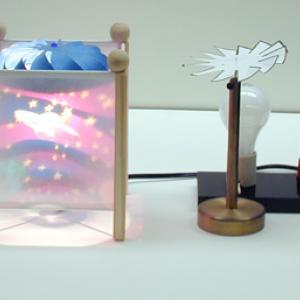College of Liberal Arts & Sciences
4B20.38 - Thermal Convection of a Gas - Convection Currents
Turn on the convection lamp and the inner part should start to rotate giving views of different planets. Set the 100 watt light bulb under the convection mobiles and turn on. The mobiles should start to spin as the hot air rises.
Light the candle or place a smoking paper inside one side of the antique convection apparatus and observe the updraft and the downdraft sides.
- R.D. Edge, "The Two-Cent Turbine or Magic Millwheel", TPT, Vol. 26, #7, Oct. 1988, p. 468.
- George W. Ficken, Jr., "Convection - Driven Oscillator", TPT, Vol. 20, #7, Oct. 1982, p. 469.
- Carl Kenty, "The Calorotor: A Simple Heat Engine with Which the Motion of Individual Molecules may be Demonstrated", AJP, Vol. 35, #12, Dec. 1967, p. 1120.
- George M. Hopkins, "Ascensional Power of Heated Air", Experimental Science, p 196.
- Carson I. A. Ritchie, "The Spinning Snake", Making Scientific Toys, p. 105.
- Charles Vivian, "Making an Air-Screw", Science Experiments & Amusements For Children, p. 4.
- Martin Gardner, "The Twisty Snake", Science Tricks, p. 28.
- Martin Gardner, "Psychic Motor?", Science Tricks, p. 27.
- Janice VanCleave, "26, Spinning Spiral", Teaching the Fun of Physics, p. 42.
- Janice Van Cleave, "58, Up Draft", Earth Science for Every Kid, p. 130.
- Janice VanCleave, "Up Draft", 201 Awesome, Magical, Bizarre, & Incredible Experiments, p. 78.
- Shoma Kutasov, Physics Demonstrations, p. 67.
- Sara Stein, "Draft Detector", The Science Book, p. 166.
Disclaimer: These demonstrations are provided only for illustrative use by persons affiliated with The University of Iowa and only under the direction of a trained instructor or physicist. The University of Iowa is not responsible for demonstrations performed by those using their own equipment or who choose to use this reference material for their own purpose. The demonstrations included here are within the public domain and can be found in materials contained in libraries, bookstores, and through electronic sources. Performing all or any portion of any of these demonstrations, with or without revisions not depicted here entails inherent risks. These risks include, without limitation, bodily injury (and possibly death), including risks to health that may be temporary or permanent and that may exacerbate a pre-existing medical condition; and property loss or damage. Anyone performing any part of these demonstrations, even with revisions, knowingly and voluntarily assumes all risks associated with them.
